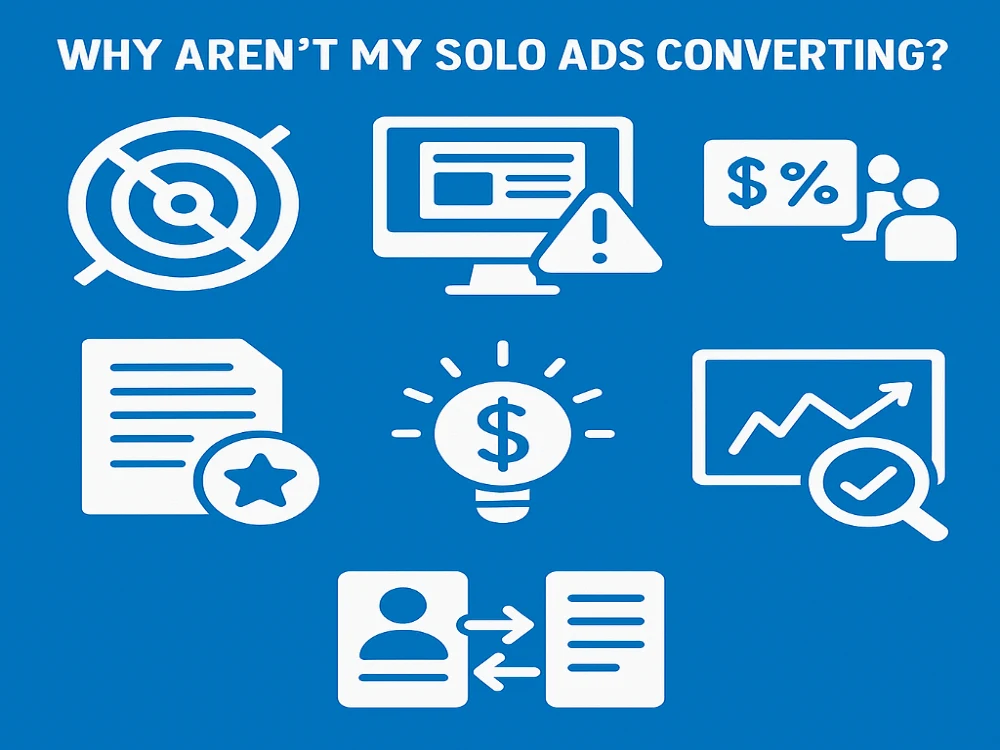
If you’ve ever invested in solo ads, you probably expected a rush of leads and sales to flood your inbox. After all, the idea sounds simple: pay for clicks from someone else’s email list, sit back, and watch conversions roll in.
But then reality hits. You spend $100, $200, or even more on solo ad traffic — and get almost nothing in return. No sales, barely any leads, and a sinking feeling that solo ads are a scam.
The truth? Solo ads can work, but only if you understand how they actually fit into a marketing funnel. If your solo ads aren’t converting, chances are you’re making one (or more) of the common mistakes below.
Let’s break down the real reasons solo ads don’t convert — and the practical fixes you can apply today.
1. You’re Targeting the Wrong Audience
The number one reason solo ads flop is poor targeting. Many solo ad sellers advertise “high-quality traffic,” but high quality for whom?
If you’re selling a weight loss supplement but the solo ad list is built around “make money online” offers, your clicks will never convert. You can have the best landing page in the world, but if the subscribers aren’t interested in your niche, it’s game over.
How to Fix It:
- Research vendors carefully — don’t just buy the cheapest clicks.
- Ask solo ad providers about their list demographics (what niche is it? what’s the average buyer’s interest?).
- Look for testimonials from people in your niche.
Start with a small test run before scaling to 500 or 1,000 clicks.
2. Your Landing Page Isn’t Optimized
Even if you get the right audience, a weak landing page can kill conversions. Many beginners send solo ad traffic to pages cluttered with too much text, distracting images, or no clear call-to-action (CTA).
Remember: people clicking on solo ads are often cold leads. They don’t know you yet, so your page needs to grab attention instantly.
Landing Page Mistakes That Hurt Conversions:
- Slow load speed (mobile users leave instantly).
- Too many CTAs (confuses the visitor).
- No clear headline explaining the benefit.
- Weak or irrelevant lead magnet.
How to Fix It:
- Keep it simple: one headline, one opt-in form, one CTA.
- Make sure it loads fast (use tools like GTMetrix or Google PageSpeed).
Offer a lead magnet that solves a burning problem in your niche (e.g., “Free 7-Day Fat Loss Meal Plan” for health offers, or “Free Guide: 10 Ways to Make Your First $100 Online” for MMO offers).
3. Your Offer Doesn’t Match the Traffic
Another big mistake: mismatched offers. Imagine clicking an ad that promises “free email marketing secrets,” only to land on a page trying to sell you a $297 coaching program immediately. That disconnect kills trust and conversions.
Solo ad traffic works best when you start with a freebie or low-barrier entry point, like a free guide, webinar, or checklist. Then, you nurture the leads via email before pitching a higher-ticket product.
How to Fix It:
- Align your ad copy, landing page, and offer — keep the promise consistent.
- Test different lead magnets to see which one your audience wants most.
- Don’t expect cold solo ad clicks to buy a $1,000 course on day one.
4. You’re Using Low-Quality Solo Ad Vendors
Let’s be real: the solo ad industry has a bad reputation for a reason. Some sellers use fake clicks, bots, or recycled email lists that haven’t been engaged in years. That’s why you might see 100 clicks but zero opt-ins.
How to Spot Low-Quality Vendors:
- They promise “guaranteed sales” (big red flag).
- Their traffic is way cheaper than everyone else’s.
- No reviews, no testimonials, no transparency.
How to Fix It:
- Buy from trusted platforms like Udimi, TrafficForMe, or reputable individual sellers with a proven track record.
- Track every click with tools like ClickMagick or Voluum to verify real traffic.
- Build relationships with good vendors — stick with those who deliver.
5. You’re Expecting Instant Sales
One of the biggest myths about solo ads is that they’re a “buy clicks → make sales instantly” shortcut. In reality, solo ads are best used for list building, not instant profits.
Think of solo ads as a way to rent someone’s list so you can start growing your own. From there, your follow-up emails do the heavy lifting to convert leads into buyers.
How to Fix It:
- Set realistic expectations — don’t expect to make your money back on day one.
- Build an automated email sequence that educates, builds trust, and gradually introduces your offer.
- Track open rates and click-through rates to see which emails perform best.
6. You’re Not Tracking & Split Testing
If you’re buying traffic without tracking results, you’re flying blind. Many solo ad beginners don’t know which clicks are converting, or whether their opt-in form is even working properly.
How to Fix It:
- Use a tracking tool (ClickMagick, Voluum, or even Google Analytics).
- Split test your landing pages (headlines, button colors, CTA wording).
- Test different email subject lines in your follow-up sequence.
Tracking and testing let you see what’s working, cut what’s not, and scale profitable campaigns.
Final Thoughts: Solo Ads Can Work — If You Do Them Right
Solo ads aren’t magic, but they aren’t scams either. The reason most beginners fail is that they expect traffic alone to guarantee sales. In reality, successful solo ad campaigns depend on three things:
- Choosing the right solo ad vendor with a targeted list.
- Creating a simple, optimized landing page that converts clicks into leads.
- Building a relationship through email before asking for the sale.
If your solo ads aren’t converting, don’t give up — fix the leaks in your funnel first. With the right strategy, solo ads can be a powerful tool to grow your list and generate consistent sales.
✅ Pro Tip: Always start small. Test 100–200 clicks, track results, and optimize before investing big.



